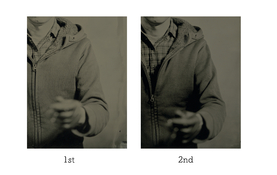Hi,
I've been practicing tintype photography for about 1.5 years and have three questions. I would appreciate it if someone with extensive knowledge could answer.
When I take the plate out of the silver nitrate before shooting, the collodion sometimes appears as Silver “white” (Opaque white), while other times it is considerably weaker and thin, almost gray (on the black plate). It puzzled me, so I recently conducted tests by varying the temperatures of the chemicals, changing the room temperature, altering the method of flowing collodion, and adjusting the time between collodion and silver nitrate. However, there wasn't much change. The thickness of the collodion seems to vary.
1) What factors could influence this?
I've noticed that when the collodion is “whiter”, the image appears to look a bit brighter.
2) Does the opacity of collodion affect sensitivity?
A related question is that under nearly identical conditions (strobe light intensity, the temperature of the silver nitrate, salted collodion, and developer, the room that I am working at, and setting time for collodion before silver nitrate), I sometimes get variations of 1/3 to 3/4 stop in speed. This occurs even when shooting within an hour on the same day. I understand that wet plate photography involves various variable factors, but a difference of more than 1/2 significantly alters the impression of the image.
3)Could you please suggest any possible reasons for this exposure variation?
Note: I use 5x7 inch plates, and my collodion consists of KI and CdBr2, primarily for photographing people.
Thank you!
I've been practicing tintype photography for about 1.5 years and have three questions. I would appreciate it if someone with extensive knowledge could answer.
When I take the plate out of the silver nitrate before shooting, the collodion sometimes appears as Silver “white” (Opaque white), while other times it is considerably weaker and thin, almost gray (on the black plate). It puzzled me, so I recently conducted tests by varying the temperatures of the chemicals, changing the room temperature, altering the method of flowing collodion, and adjusting the time between collodion and silver nitrate. However, there wasn't much change. The thickness of the collodion seems to vary.
1) What factors could influence this?
I've noticed that when the collodion is “whiter”, the image appears to look a bit brighter.
2) Does the opacity of collodion affect sensitivity?
A related question is that under nearly identical conditions (strobe light intensity, the temperature of the silver nitrate, salted collodion, and developer, the room that I am working at, and setting time for collodion before silver nitrate), I sometimes get variations of 1/3 to 3/4 stop in speed. This occurs even when shooting within an hour on the same day. I understand that wet plate photography involves various variable factors, but a difference of more than 1/2 significantly alters the impression of the image.
3)Could you please suggest any possible reasons for this exposure variation?
Note: I use 5x7 inch plates, and my collodion consists of KI and CdBr2, primarily for photographing people.
Thank you!



